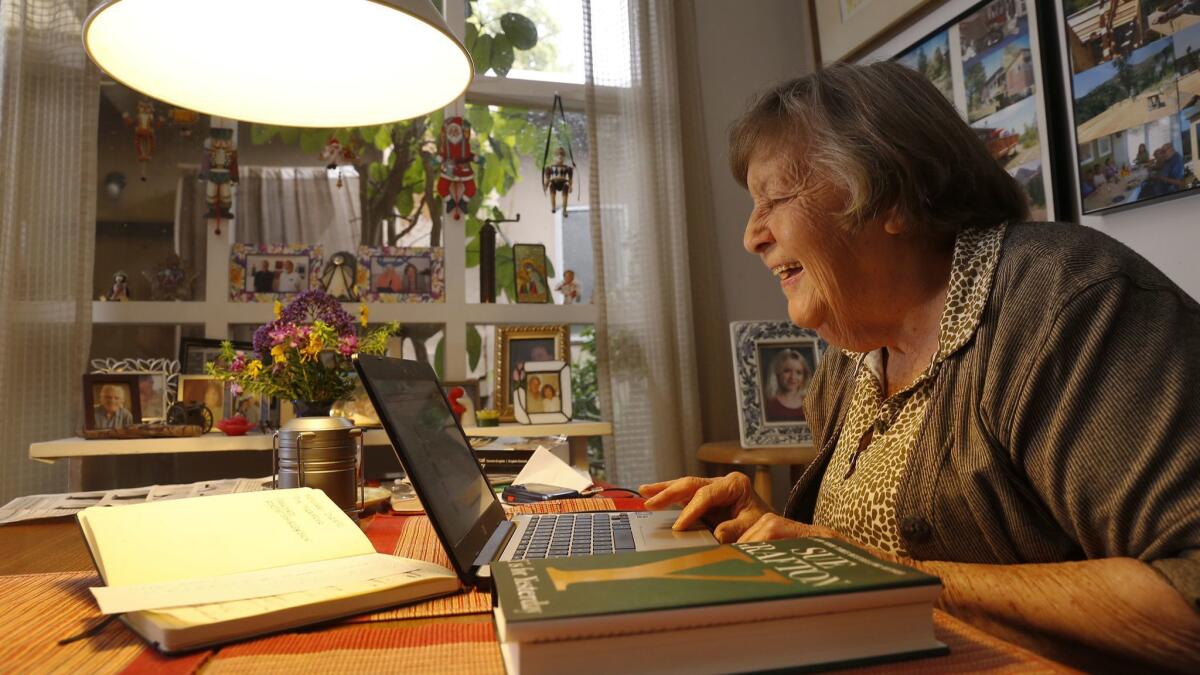Despite evacuation warnings, some Montecito residents have had enough

- Share via
Reporting from Montecito, Calif. — Weary of repeated orders in recent weeks telling them to pack their bags and flee, some Montecito residents ignored officials’ latest warnings of flooding and debris flows, choosing to wait out a powerful storm at home.
Ruth Pedersen, a 92-year-old widow, was among them.
“It takes a lot for me to be scared. I don’t think I will ever choose to evacuate,” Pedersen said. “I see my neighbors return, and it’s been their fifth time evacuating — and they look tired.”
Pedersen has lived in the house her husband, Aage, built on Orchard Avenue for 61 years. Since he died seven years ago she’s lived alone.
“I’m being vigilant,” she said, pointing to a purple bag near her door. “I always have my pj’s in there, and important paperwork, if I have to suddenly leave.”
Since the January mudslides that killed 21 people, Montecito residents have been on high alert.
No fewer than three times in recent weeks, authorities have asked thousands to flee, warning that if they stayed behind they would risk their lives and possibly those of rescue workers. But when forecasters’ predictions didn’t materialize time and again, a kind of disaster fatigue settled in.
Still, told earlier this week that a powerful storm could deliver another damaging blow to the region, many residents heeded officials’ orders and left town.
Of the nearly 1,200 Montecito residents Santa Barbara County sheriff’s deputies spoke with near Montecito creek beds, about 75% said they were planning to leave, a county spokesperson said. That represents a marked improvement from January, when according to officials only about 15% of those living in mandatory evacuation zones took off before the storm.
In the aftermath of the Jan. 9 mudflow, Santa Barbara County created and publicized a more formal process for informing the community ahead of a natural disaster. It also uses a federally created alert messaging system that reaches cellphones more reliably than it did before the disaster.
“These last couple of storms have seemed to take either a left-hand or right-hand turn when it got to Montecito,” said Sheri Benninghoven, a county spokeswoman. “That has been really good for us, but really challenging for helping the public know that they did need to honor this evacuation.”
Carla Case Flynn of Montecito said she hasn’t evacuated since the Thomas fire in December. This week’s evacuation order was at least the fifth time in four months she and her family had been told to leave.
“I’ve made a pact with my brother and husband that if we decide not to leave, we will be vigilant,” she said. “We each stay awake at different times and monitor the situation.”
Flynn’s house, where she has lived since 2003, sustained minor damage during the mud and debris slides. In the wake of that storm, and she and her family went three weeks without electricity or gas.
“We used buckets of water from our pool,” she said. “If we made it through Jan. 9, we think we will probably be OK.”
But if the rain does pick up, Flynn said, her car is packed and ready to go. She, her husband and her brother promised each other to not call 911 and to stay off the roads.
“We don’t want to be in the way of any first responders,” she said.

The heaviest rains fell on Southern California Thursday morning, and National Weather Service forecasters predicted that they would be followed by a cold front that “takes mercy” on Santa Barbara County, pushing the storm to the east.
The threat of heavy rains this week didn’t faze 80-year-old Shirley Thornton, who spent Thursday morning under a blanket on her couch watching the storm unfold on her TV in Montecito.
She has lived in her home on Orchard Avenue for 56 years and said her son in Louisiana has been calling frequently to check on her.
“I’ve been here long enough to know what to do. … I’m just going to wait and see what happens, watch TV and feed my cat,” she said. “I got water bottles, and I’m ready in case something happens.”
The brief but intense rains that pelted Santa Barbara and Montecito did dramatically increase the flow of Montecito Creek and other waterways that drain the area.
In an email earlier this week, written under the subject line: “Tired of Evacuating,” County Supervisor Das Williams urged residents to heed officials’ warnings.
“The risk is real,” he wrote. “We issue evacuations because it is better for you to be out of your home for a while than for you to have a story of gut wrenching survival to share, or worse: to have your name added to the list of people who have lost their lives to the Thomas fire debris flows.”
Though the worst-case scenario didn’t materialize on Thursday, the storm did flood residential streets and closed portions of Highway 33. Debris basins filled up and trees were felled across the Southland.
“I have a 2-year-old and my wife is 5 months pregnant and is working at the same time and we have evacuated 5 times,” Williams said in an email to The Times on Thursday. “Evacuating is stressful and distracts from everything we love about this place, but it’s a temporary downside versus the permanent loss from tragedy. When we are thinking of our families, our friends, and our neighbors, we should not rely on luck. The stakes are too high.”
Etehad and Vives reported from Montecito, Serna from Los Angeles. Times staff writer Anna M. Phillips in Los Angeles contributed to this report.
melissa.etehad@latimes.com | Twitter: @melissaetehad
ruben.vives@latimes.com | Twitter: @LATvives
joseph.serna@latimes.com | Twitter: @JosephSerna
More to Read
Sign up for Essential California
The most important California stories and recommendations in your inbox every morning.
You may occasionally receive promotional content from the Los Angeles Times.
















